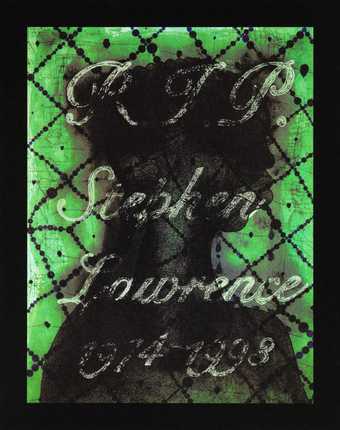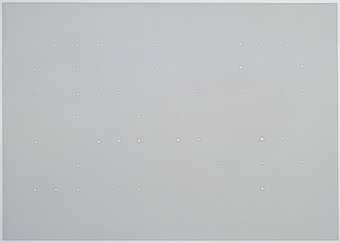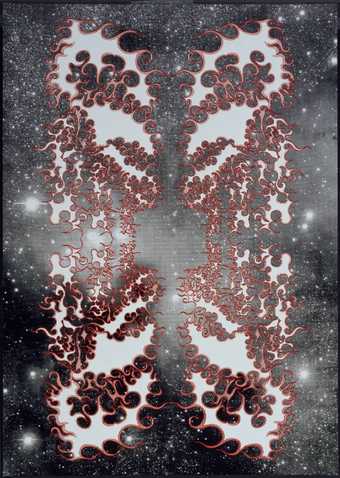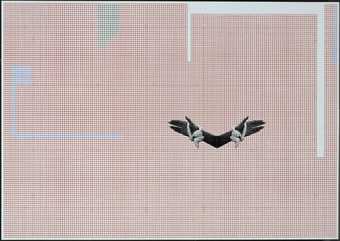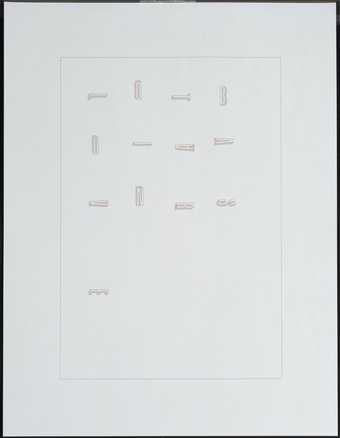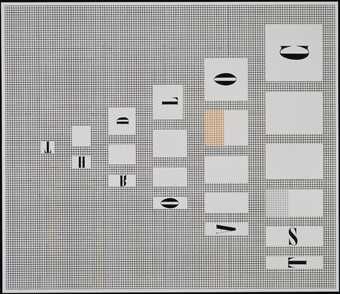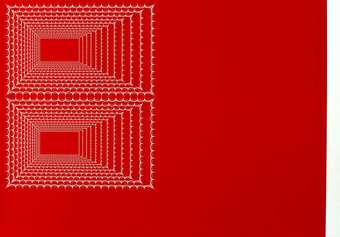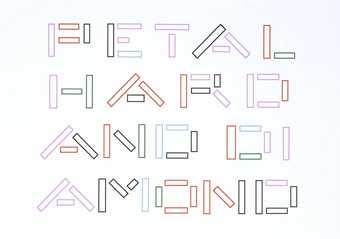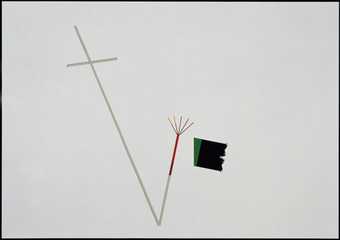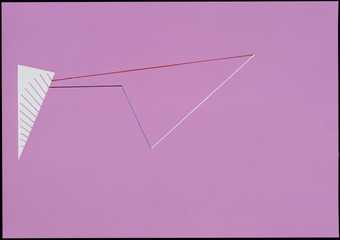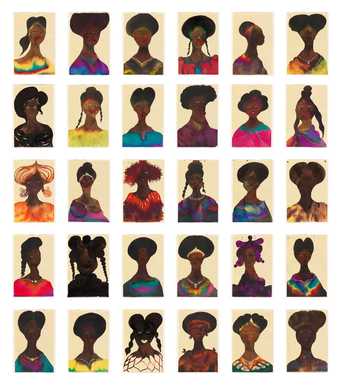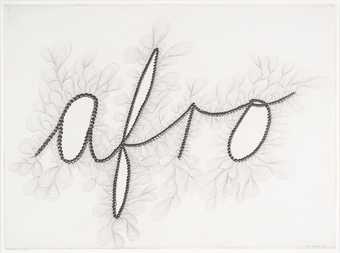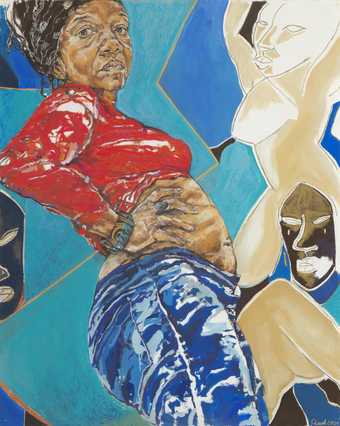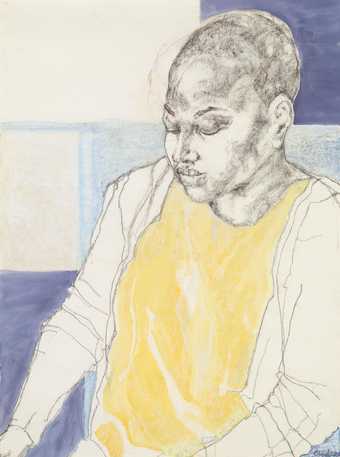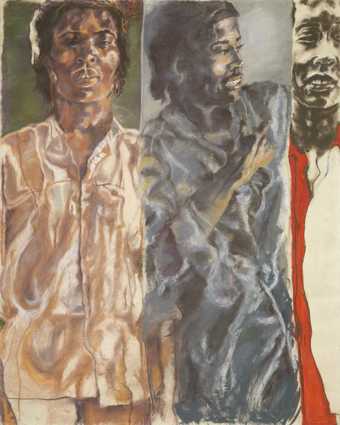
- Artist
- Claudette Johnson MBE born 1959
- Medium
- Pastel on paper
- Dimensions
- Support: 1535 × 1220 mm
frame: 1631 × 1320 × 50 mm - Collection
- Tate
- Acquisition
- Purchased 2019
- Reference
- T15261
Summary
Figure in Raw Umber 2018 is a large drawing in pastel on paper of a young black woman with close-cropped hair whose body twists towards the viewer as she gazes defiantly outwards. The drawing has been rendered using only two colours: raw umber, as suggested by the work’s title, and black, used sparingly to define creases in the model’s clothing. The skin is treated tonally, creating sensual depth through shading and smudging of pastel, while the body is rendered through quick broken lines that convey dynamic movement. In describing her process, Johnson has said:
Pushing the pastels around on oversized sheets forces me to build the forms in a physical process that is almost at the limits of my capacity. Being slightly out of control of the process, through working on the wall rather than on an easel, having the sitter behind rather than in front of me, helps to keep an element of struggle in the drawings.
(In Hollybush Gardens 2016, p.7.)
The work was drawn mostly from life in the artist’s studio in East London, occasionally supplemented by working from photographs. The sitter is Beverly Bennett, an artist who has been posing regularly for Johnson since she was introduced to her by the artist Sonia Boyce in 2014. Beverly also appears in the earlier drawing Seated Figure I 2017 (Tate T15262).
Johnson has been making larger than life drawings of Black women since the early 1980s (see also Seated Figure I 2017, Tate T15262, and Standing Figure with African Masks 2018, Tate T15143). Her figures are monolithic, seemingly to resist their containment within the edges of the paper. She usually works from life onto large sheets of paper taped to the studio wall. She begins with a dry pastel drawing, which she often paints over in sections using blocks of watercolour and gouache paint, before adding a final layer of drawing with pastel. The background, usually comprised of imagined and abstracted geometric forms, is created intuitively after the completion of the figure. The results are richly coloured and sensuous images that convey a sense of urgency in their expressive broken lines and pulsing forms.
Johnson describes her work as existing outside the realm of portraiture; rather she sees it as creating a ‘presence’ for her subject that resists objectification. She has written:
I am a Blackwoman and my work is concerned with making images of Blackwomen. Sounds simple enough – but I’m not interested in portraiture or its tradition. I’m interested in giving space to Blackwomen presence. A presence which has been distorted, hidden and denied. I’m interested in our humanity, our feelings and our politics; somethings [sic.] which have been neglected … I have a sense of urgency about our ‘apparent’ absence in a space we’ve inhabited for several centuries.
(Quoted in Claudette Johnson: Pushing Back the Boundaries, exhibition catalogue, Rochdale Art Gallery 1990, p.2.)
Johnson is motivated by an attempt to convey images of Black women without distortion or caricature, describing the difficulty of being ‘seen’. She is inspired by a generation of African American writers including James Baldwin, Toni Cade Bambara, Alice Walker and, most importantly Toni Morrison. In 2013 she stated: ‘From the moment that I read The Bluest Eye – Toni Morrison – I knew that I wanted to focus on black women as subject and form. In the novel Morrison writes about black people in a way that I could not recall ever having experienced before. It felt revelatory.’ (Quoted in Himid 2013, p.64.) She has often cited the treatment of Morrison’s central character Pecola, in particular her encounter with a white Southern shopkeeper, as a key source of inspiration because it illuminated ‘How impossible it was for a Southern shopkeeper to “see” her, yet how powerfully and accurately she could see him. How alive and vibrant she was inside and outside of the construct he had made of her.’ (Quoted in Claudette Johnson: Portraits from a Small Room, exhibition catalogue, 198 Gallery, London 1994, p.5.)
Johnson trained as an artist at Wolverhampton Polytechnic between 1979 and 1982 where she co-founded the Blk Art Group alongside artists Keith Piper, Eddie Chambers and Donald Rodney and, later, Marlene Smith. She played a key role in the formation of a Black British feminist art movement that developed in the 1980s, and participated in all three of the exhibitions curated by artist Lubaina Himid that have since defined the movement: Five Black Women at The Africa Centre and Black Woman Time Now at Battersea Arts Centre (both 1983), as well as The Thin Black Line at the Institute for Contemporary Arts in London (1985). Johnson has maintained a commitment to figuration throughout her career. In 2013 she said, ‘I felt that the figure could express everything; through figuration, abstraction and invention I could tell personal and in its widest sense political truths’ (quoted in Himid 2013, p.64).
Further reading
Lubaina Himid, Thin Black Line(s), exhibition catalogue, Tate Britain, London 2013.
Claudette Johnson, ‘Artist Statement’, in Carte de Visite, exhibition catalogue, Hollybush Gardens, London 2016.
Sonya Dyer, ‘Claudette Johnson’, frieze magazine, no.193, December 2017, https://frieze.com/article/claudette-johnson, accessed 15 October 2018.
Laura Castagnini
October 2018
Does this text contain inaccurate information or language that you feel we should improve or change? We would like to hear from you.
You might like
-
Chris Ofili R.I.P. Stephen Lawrence 1974 - 1993
2013 -
Richard Wright Untitled Figure 2
2002 -
Richard Wright Untitled Figure 3
2002 -
Richard Wright Untitled Figure 4
2002 -
Richard Wright Untitled Figure 5
2002 -
Richard Wright Untitled Figure 6
2002 -
Richard Wright Untitled Figure 1
2001 -
Richard Wright Untitled Figure 3
2001 -
Richard Wright Untitled Figure 4
2001 -
Richard Wright Untitled Figure 5
2001 -
Chris Ofili Untitled
1998 -
Chris Ofili afro
2000 -
Claudette Johnson MBE Standing Figure with African Masks
2018 -
Claudette Johnson MBE Seated Figure 1
2017 -
Claudette Johnson MBE Untitled
1987

